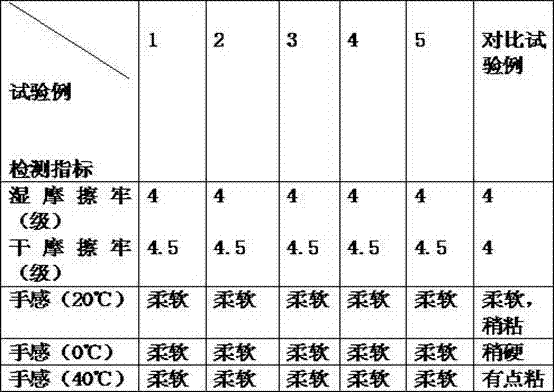Leather printing paste and preparation method thereof
A printing paste and leather technology, which is applied in the field of leather printing paste, can solve the problems affecting the leather printing feel, cold-touch brittleness, hot-stick cold-brittleness, etc., and achieves the effects of good elasticity, soft touch and strong color-fixing ability.
- Summary
- Abstract
- Description
- Claims
- Application Information
AI Technical Summary
Problems solved by technology
Method used
Image
Examples
Embodiment 1
[0059] Embodiment 1, A1 component preparation:
[0060] (1) 180 parts of polyoxypropylene ether diol (number average molecular weight 2000), 4.5 parts of 1,4-butanediol, 2 parts of trimethylol propane, 10 parts of dimethylol propionic acid, toluene diisocyanate Add 56 parts of (TDI), 0.03 parts of dibutyltin dilaurate, and 30 parts of acetone into the reaction kettle in turn, stir and heat up, and react at 70±2°C for 7 hours to prepare a polyurethane prepolymer;
[0061] (2) Then add 12.6 parts of glycidol and react at 77±2°C for 4.5 hours to obtain a glycidol-terminated polyurethane prepolymer;
[0062] (3) Put the above-mentioned glycidol-terminated polyurethane prepolymer into an emulsification kettle, cool down to 30±2°C, add 7.5 parts of triethylamine and stir evenly, stir quickly, add 590 parts of deionized water for emulsification, and emulsification is complete Finally, add 8.9 parts of thickener and stir for 40 minutes to obtain epoxy-based polyurethane resin printi...
Embodiment 2
[0063] Embodiment 2, A2 component preparation:
[0064](1) 180 parts of polyoxypropylene ether diol (number average molecular weight 1800), 5 parts of neopentyl glycol, 3 parts of trimethylolpropane, 11 parts of dimethylol butyric acid, toluene diisocyanate (TDI) 30 parts, 29.4 parts of 1.6-hexamethylene diisocyanate (HDI), 36 parts of dimethylformamide, and 0.04 parts of dibutyltin acetate were added to the reaction kettle in sequence, stirred and heated up, and reacted at 76±2°C for 7 hours to obtain Polyurethane prepolymer;
[0065] (2) Then add 13.4 parts of glycidol and react at 76±2°C for 5 hours to obtain a glycidol-terminated polyurethane prepolymer;
[0066] (3) Put the glycidol-terminated polyurethane prepolymer in the emulsification kettle, cool down to 30±2°C, add 7.5 parts of triethylamine and stir evenly, then stir quickly, add 600 parts of deionized water for emulsification, after emulsification , add 9 parts of thickener, and stir for 50 minutes to prepare ...
Embodiment 3
[0067] Embodiment 3, A3 component preparation:
[0068] (1) 190 parts of polyoxypropylene ether diol (number average molecular weight 2500), 2.5 parts of 1,4-butanediol, 2.5 parts of neopentyl glycol, 3.5 parts of trimethylolpropane, dimethylolpropane Add 13.4 parts of acid, 80.5 parts of isophorone diisocyanate (IPDI), 0.04 parts of dibutyltin dilaurate, 20 parts of N-methylpyrrolidone, and 20 parts of acetone. ℃ for 7 hours to prepare a polyurethane prepolymer;
[0069] (2) Then add 14.2 parts of glycidol and react at 77±2°C for 4.5 hours to obtain a glycidol-terminated polyurethane prepolymer;
[0070] (3) Put the glycidol-terminated polyurethane prepolymer in the emulsification kettle, cool down to 25±2°C, add 10.1 parts of triethylamine and stir evenly, then stir quickly, add 690 parts of deionized water for emulsification, after emulsification , add 10.5 parts of thickener and stir for 45 minutes to prepare epoxy-based polyurethane resin printing paste A3.
PUM
 Login to View More
Login to View More Abstract
Description
Claims
Application Information
 Login to View More
Login to View More - R&D
- Intellectual Property
- Life Sciences
- Materials
- Tech Scout
- Unparalleled Data Quality
- Higher Quality Content
- 60% Fewer Hallucinations
Browse by: Latest US Patents, China's latest patents, Technical Efficacy Thesaurus, Application Domain, Technology Topic, Popular Technical Reports.
© 2025 PatSnap. All rights reserved.Legal|Privacy policy|Modern Slavery Act Transparency Statement|Sitemap|About US| Contact US: help@patsnap.com

